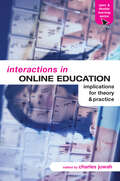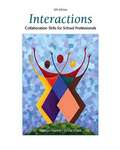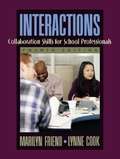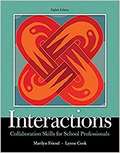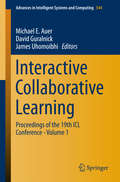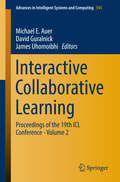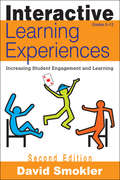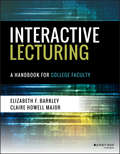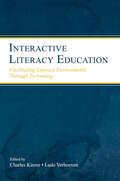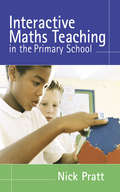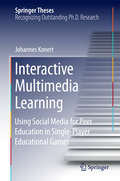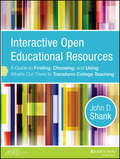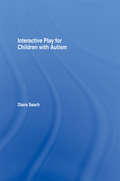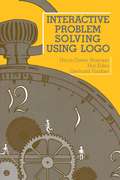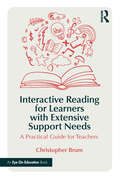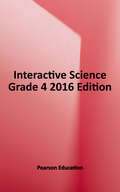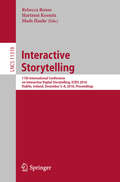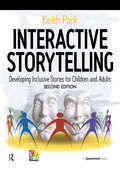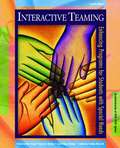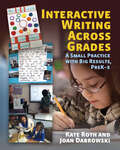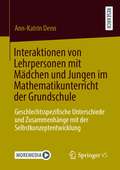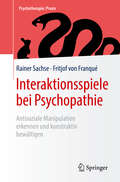- Table View
- List View
Interactions in Online Education: Implications for Theory and Practice (Open and Flexible Learning Series)
by Charles JuwahInteractivity is at the very heart of learning and is evident at all levels of engagement, whether between fellow students, students and tutors, online learning materials or interfacing with the learning environment. Covering both theory and the practical implications of the issues discussed, this book provides international perspectives on key topics including: analysing and designing e-learning interactions, social and conceptual dimensions of learning, interactions in online discussions, interactions in peer learning and professional development of online facilitators. It is essential reading for all those involved in the design, implementation, management and use of open and flexible learning.
Interactions: Collaboration Skills for School Professionals
by Marilyn Friend Lynne CookTargeted at services for students with special needs, this text provides collaboration techniques between educators fraternity - special educators, general educators and related services professionals - to work towards effective communication framework.
Interactions: Collaboration Skills for School Professionals (4th Edition)
by Marilyn Friend Lynne CookInteractions, Fourth Edition, provides a cutting-edge look at how teams of school professionals-classroom teachers, special education teachers, and counselors-can effectively work together to provide a necessary range of services to students with special needs. This book addresses collaboration as a style, with accompanying knowledge and skills, which guides practices in many education efforts. As a result, future teachers learn how to collaborate with school professionals and families to help special education students who are more often being placed in general classroom settings.
Interactions: Collaboration Skills for School Professionals (Eighth Edition)
by Marilyn Friend Lynne CookWe intend for the book to be a useful tool for preservice educators and practitioners in improving their skills and deepening their understanding, whether they are engaged in formal instructional settings, study groups, or independent study.
Interactive Collaborative Learning
by James Uhomoibhi Michael E. Auer David GuralnickThis book presents the proceedings of the 19th International Conference on Interactive Collaborative Learning, held 21-23 September 2016 at Clayton Hotel in Belfast, UK. We are currently witnessing a significant transformation in the development of education. The impact of globalisation on all areas of human life, the exponential acceleration of developments in both technology and the global markets, and the growing need for flexibility and agility are essential and challenging elements of this process that have to be addressed in general, but especially in the context of engineering education. To face these topical and very real challenges, higher education is called upon to find innovative responses. Since being founded in 1998, this conference has consistently been devoted to finding new approaches to learning, with a focus on collaborative learning. Today the ICL conferences have established themselves as a vital forum for the exchange of information on key trends and findings, and of practical lessons learned while developing and testing elements of new technologies and pedagogies in learning.
Interactive Collaborative Learning
by James Uhomoibhi Michael E. Auer David GuralnickThis book presents the proceedings of the 19th International Conference on Interactive Collaborative Learning, held 21-23 September 2016 at Clayton Hotel in Belfast, UK. We are currently witnessing a significant transformation in the development of education. The impact of globalisation on all areas of human life, the exponential acceleration of developments in both technology and the global markets, and the growing need for flexibility and agility are essential and challenging elements of this process that have to be addressed in general, but especially in the context of engineering education. To face these topical and very real challenges, higher education is called upon to find innovative responses. Since being founded in 1998, this conference has consistently been devoted to finding new approaches to learning, with a focus on collaborative learning. Today the ICL conferences have established themselves as a vital forum for the exchange of information on key trends and findings, and of practical lessons learned while developing and testing elements of new technologies and pedagogies in learning.
Interactive Learning Experiences, Grades 6-12: Increasing Student Engagement and Learning
by David Samuel SmoklerDiscover how to engage teenagers in course content using this resource's updated research, new sample activities, and tips for designing and evaluating interactive learning experiences.
Interactive Lecturing: A Handbook for College Faculty
by Elizabeth F. Barkley Claire H. MajorTips and techniques to build interactive learning into lecture classes Have you ever looked out across your students only to find them staring at their computers or smartphones rather than listening attentively to you? Have you ever wondered what you could do to encourage students to resist distractions and focus on the information you are presenting? Have you ever wished you could help students become active learners as they listen to you lecture? Interactive Lecturing is designed to help faculty members more effectively lecture. This practical resource addresses such pertinent questions as, “How can lecture presentations be more engaging?” “How can we help students learn actively during lecture instead of just sitting and passively listening the entire time?” Renowned authors Elizabeth F. Barkley and Claire H. Major provide practical tips on creating and delivering engaging lectures as well as concrete techniques to help teachers ensure students are active and fully engaged participants in the learning process before, during, and after lecture presentations. Research shows that most college faculty still rely predominantly on traditional lectures as their preferred teaching technique. However, research also underscores the fact that more students fail lecture-based courses than classes with active learning components. Interactive Lecturing combines engaging presentation tips with active learning techniques specifically chosen to help students learn as they listen to a lecture. It is a proven teaching and learning strategy that can be readily incorporated into every teacher’s methods. In addition to providing a synthesis of relevant, contemporary research and theory on lecturing as it relates to teaching and learning, this book features 53 tips on how to deliver engaging presentations and 32 techniques you can assign students to do to support their learning during your lecture. The tips and techniques can be used across instructional methods and academic disciplines both onsite (including small lectures and large lecture halls) as well as in online courses. This book is a focused, up-to-date resource that draws on collective wisdom from scholarship and practice. It will become a well-used and welcome addition for everyone dedicated to effective teaching in higher education.
Interactive Literacy Education: Facilitating Literacy Environments Through Technology
by Ludo Verhoeven Charles KinzerInteractive Literacy Education combines the latest research and theory related to technology-based instructional design for children’s literacy development. It shows how technology can be used to build literacy learning environments that are compatible with students’ cognitive and social processes. Topics addressed throughout this enlightening work include:*technology environments and applications that preservice teachers can use with young children;*detailed information regarding the development and implementation of specific technological programs; and*various technologies, from interactive reading and spelling programs to speech recognition to multimedia, that teachers can use to enhance their literacy learning environments. Interactive Literacy Education is intended for graduate courses in methods of literacy instruction; educational technology; curriculum/curriculum design; general preservice education; special education; and applied psychology/cognitive studies. It is also appropriate for use as a supplement in undergraduate courses in methods of literacy instruction and educational technology.
Interactive Maths Teaching in the Primary School
by Dr Nick Pratt'Nick Pratt's book looks in detail at the real meaning of teaching mathematics interactively in primary schools. Each section is set clearly within a context, is linked by 'key ideas' - the important bits to think about - and is summarised to give a succinct close to the chapter's content and thinking. It is a book that the reader will definitely find useful and thought provoking. It certainly made me consider how small changes and a wider variety of approaches in the classroom can make big changes in children's learning and understanding of mathematical concepts' - Mike Eatwell, Primary Maths Advisor, Bristol LEA Using a whole-class, interactive approach to teaching mathematics is a key feature of the National Numeracy Strategy (NNS), and this book looks at not only what works but also why things work. Teachers will be able to understand why and how the various teaching strategies they are using in their classrooms have a positive effect on children's learning. The book covers: " how to engage in meaningful reflective practice that will improve your lessons " how to use whiteboards " making mathematical meaning through talk " getting the whole class interacting " thinking, talking and acting mathematically " teaching number - starting points " teaching shape and space - starting points " developing your interactive teaching " a glossary of terms It is aimed at both practising and trainee teachers, and offers clear subject guidance as well as an explanation of a key part of the NNS. It supports both individuals and mathematics subject leaders delivering INSET to their colleagues.
Interactive Multimedia Learning
by Johannes KonertThis book introduces new concepts and mechanisms regarding the usage of both social media interactions and artifacts for peer education in digital educational games. Digital games in general, and digital educational games in particular, represent an area with a high potential for interdisciplinary innovation, not only from an information technology standpoint, but also from social science, psychological and didactic perspectives. This book presents an interdisciplinary approach to educational games, which is centered on information technology and aims at: (1) improving digital management by focusing on the exchange of learning outcomes and solution assessment in a peer-to-peer network of learners; (2) achieving digital implementation by using forms of interaction to change the course of educational games; and (3) providing digital support by fostering group-formation processes in educational situations to increase both the effects of educational games and knowledge exchange at the individual level. In addition to a systematic analysis of the relationship between software architecture, educational games and social media applications, the book also presents the implemented IT systems' architectures and algorithmic solutions as well as the resulting applicable evaluation findings from the field of interactive multimedia learning.
Interactive Open Educational Resources: A Guide to Finding, Choosing, and Using What's Out There to Transform College Teaching
by John D. ShankA Choice Outstanding Academic Title for 2014!Sponsored by the Association of College and Research Libraries (ACRL), this one-of-a-kind book demonstrates the best tools, resources, and techniques for discovering, selecting, and integrating interactive open educational resources (OERs) into the teaching and learning process. The author examines many of the best repositories and digital library websites for finding high quality materials, explaining in depth the best practices for effectively searching these repositories and the various methods for evaluating, selecting, and integrating the resources into the instructor’s curriculum and course assignments, as well as the institution’s learning management system.
Interactive Play for Children with Autism
by Diana SeachThis is a comprehensive guide to establishing shared play experiences that assist in the development of communication, social understanding and cognition. Easily accessible, and packed full of practical resources, the book defines the importance of play both developmentally and psychologically as having a major influence on the enrichment of meaningful interactions and children’s learning. Diana Seach expertly discusses how play enables children with Autism to: represent their knowledge of the world and their relationships with others spontaneously explore ways of thinking about themselves and the objects they encounter develop communication and companionship discover motivating ways to learn extend their imagination and creative potential. Those who live and work with children who have Autism and Asperger Syndrome will find Interactive Play for Children with Autism an invaluable tool when implementing strategies to develop interactive play in educational establishments, care settings and the family home.
Interactive Problem Solving Using Logo
by Heinz-Dieter Boecker Hal Eden Gerhard FischerThis book is unique in that its stress is not on the mastery of a programming language, but on the importance and value of interactive problem solving. The authors focus on several specific interest worlds: mathematics, computer science, artificial intelligence, linguistics, and games; however, their approach can serve as a model that may be applied easily to other fields as well. Those who are interested in symbolic computing will find that Interactive Problem Solving Using LOGO provides a gentle introduction from which one may move on to other, more advanced computational frameworks or more formal analysis. What is of primary importance, however, is the text's ability -- through its presentation of rich, open-ended problems -- to effectively cultivate crucial cognitive skills.
Interactive Reading for Learners with Extensive Support Needs: A Practical Guide for Teachers
by Christopher BrumThis comprehensive guidebook shows teachers how to implement high-quality evidence-based interactive reading lessons for children with extensive support needs. It features step-by-step instructions for developing, implementing, and assessing shared reading lessons that are meaningful, engaging, and supportive of this population’s needs across cognitive, sensory, physical, and behavioral domains. Featuring templates to help readers organize critical information needed to plan and implement each lesson, as well as sample assessments to help identify learner interests, identify baseline skills, and monitor progress, the book is both practical and widely applicable across grade bands and curricula. Interactive Reading for Learners with Extensive Support Needs is key reading for teachers and literacy coaches who work with children with complex support needs, as well as faculty in personnel preparation programs in the areas of sensory disabilities, severe disabilities, and special education.
Interactive Science
by Pearson EducationBy combining new features with the proven approach of Interactive Science, this new digital update for Grades K-8 is correlated to the NGSS (Next Generation Science Standards) and will provide students with the tools to activate their inner scientist. <p><p>Interactive Science enables students aged 5-14 to connect to science concepts in a unique way that makes learning more personal, relevant and engaging. The program offers three pathways for learning and is fully flexible to fit alongside any curriculum. <p><p>The ©2016 update of Interactive Science focuses on an implementation of Problem-Based Learning, STEM, Performance Expectation activities and support for new standards while transitioning to a brand-new digital platform, Realize. The planning and development of Interactive Science was informed by the same foundational research as the NGSS Framework. Correlations can be found throughout the 2016 program. Find out more about the NGSS framework and how Pearson is supporting the transition.
Interactive Storytelling: 11th International Conference on Interactive Digital Storytelling, ICIDS 2018, Dublin, Ireland, December 5–8, 2018, Proceedings (Lecture Notes in Computer Science #11318)
by Rebecca Rouse Hartmut Koenitz Mads HaahrThis book constitutes the refereed proceedings of the 11th International Conference on Interactive Digital Storytelling, ICIDS 2018, held in Dublin, Ireland, in December 2018. The 20 revised full papers and 16 short papers presented together with 17 posters, 11 demos, and 4 workshops were carefully reviewed and selected from 56, respectively 29, submissions. The papers are organized in the following topical sections: the future of the discipline; theory and analysis; practices and games; virtual reality; theater and performance; generative and assistive tools and techniques; development and analysis of authoring tools; and impact in culture and society.
Interactive Storytelling: Developing Inclusive Stories for Children and Adults
by Keith ParkInteractive storytelling, where the story is spoken or chanted, began as a way to include individuals with severe and profound learning disabilities in larger group activities, whether children at school or adults in day services. The stories are performed in call-and-response - one person calls out a line and the rest of the group respond either by calling back the same line or by calling out a pre-arranged response - and require no previous experience in drama or storytelling. They can be performed anywhere, by anyone. Various stories are explored, ranging from folktales and pantomime to poetry, the works of Charles Dickens, Shakespeare and stories from the Old Testament. Each extract details the full call-and-response for performing the story. This approach to storytelling can be used by teachers and group facilitators in a variety of settings and with any group of children or adults, irrespective of their level of disability. This hands-on manual will enable teachers, therapists, parents and anyone working with children or adults in community settings to use performance and recital to bring stories, drama and poetry to life for people of all abilities. 'This book is a useful resource...is simply written...is especially appropriate for people working with children and adults with speech, language and communication difficulties.' - Child Language Teaching and Therapy.
Interactive Teaming: Enhancing Programs for Students with Special Needs (4th edition)
by Vivian Ivonne Correa Hazel Jones Carol Chase Thomas Catherine Voelker MorsinkInteractive teaming in special programs is a concept of service delivery for school-age students who are currently placed in special education programs or are at risk for referral to such programs.
Interactive Writing Across Grades: A Small Practice with Big Results
by Kate Roth Joan DabrowskiWhen done on a regular basis, interactive writing has the potential to improve independent writing. Authors Kate Roth and Joan Dabrowski detail how this systemic approach can be applied in Interactive Writing Across Grades: A Small Practice with Big Results, PreK-5.' Interactive writing harnesses the natural interactions teachers have with their students as they compose a writing piece. It allows for real-time differentiation and tailored scaffolding. This method fits within any basal writing curriculum and can be adapted to your classroom's technology levels. This book acts as a how-to guide that unpacks this powerful method, going step-by-step and grade-by-grade to figure out where and how interactive writing fits within your literacy framework. Inside you'll find:A complete overview of the interactive writing method and how it fits into your balanced literacy program Concrete ways to launch interactive writing in your classroom to support both process and craft instruction Step-by-step guidance to implement the method with students of all ages Student examples of writing from grades Pre-K through 5 to show what to expect at each phase of the process 'Listen in on a Lesson vignettes that demonstrate the type of scaffolding you can offer during interactive writing lessons Discover what makes interactive writing a particularly effective teaching practice that can support both emergent and fluent writers. Interactive Writing Across Grades can help put this method to work in the classroom immediately. '
Interaktion zwischen frühpädagogischen Fachkräften und Eltern in der Kindertagesstätte: Eine rekonstruktive Analyse professionalisierter Praxis
by Annika KallfaßIn den letzten Jahrzehnten ist der Besuch einer Kindertagesstätte Teil der Normalbiografie von Kindern in Deutschland geworden und die Zeit, die Kinder in der Obhut frühpädagogischer Fachkräfte verbringen, hat sich verlängert. Diese Veränderung im generationalen Sorgeverhältnis wirft die Frage auf, welche Beziehungskonstellationen heute zwischen Kindern, Eltern und frühpädagogischen Fachkräften in Kindertagesstätten existieren. Obwohl dem Thema bereits große Aufmerksamkeit gewidmet wurde, ist die Datenbasis über das berufliche Wissen und Handeln frühpädagogischer Fachkräfte immer noch unzureichend. Forschungslücken werden insbesondere in Bezug auf die kollektive, organisationale und performative Dimension beruflichen Handelns festgestellt sowie bezogen auf die Grundfrage, wie Ziel und Güte beruflichen Handelns definiert werden können. In der vorliegenden Untersuchung werden videografierte Elterngespräche in Kindertagesstätten sowie audiografierte Gruppendiskussionen von frühpädagogischen Fachkräfte-Teams aus praxeologisch-wissenssoziologischer Perspektive bearbeitet. Die Ergebnisse sprechen dafür, Professionalisierungsprozesse in der Frühpädagogik nicht nur auf der individuellen Ebene der einzelnen Fachkraft zu adressieren, sondern sie im Zusammenhang mit Prozessen der Organisationsentwicklung anzuregen und zu fördern.
Interaktionen von Lehrpersonen mit Mädchen und Jungen im Mathematikunterricht der Grundschule: Geschlechtsspezifische Unterschiede und Zusammenhänge mit der Selbstkonzeptentwicklung
by Ann-Katrin DennMithilfe videobasierter Beobachtungen geht Ann-Katrin Denn in diesem Buch der Frage nach, ob Mädchen und Jungen im Unterrichtsgespräch des Mathematikunterrichts in der Grundschule von Lehrpersonen unterschiedlich eingebunden werden (bspw. durch Fragen, Aufrufe oder Feedback). Aufgrund der geschlechtsspezifischen Unterschiede im mathematischen Selbstkonzept wird außerdem untersucht, ob sich Aspekte der Interaktion unterschiedlich auf die Selbstkonzeptentwicklung von Mädchen und Jungen auswirken.
Interaktionsspiele bei Psychopathie: Antisoziale Manipulation erkennen und konstruktiv bewältigen (Psychotherapie: Praxis)
by Rainer Sachse Fritjof von FranquéIm vorliegenden Buch wird beschrieben, wie manipulatives Handeln von Personen mit Psychopathie erkannt und bewältigt werden kann. Die psychopathische Persönlichkeitsstörung (engl.: Psychopathy) ist definiert durch eine Kombination aus interaktionellen, affektiven, antisozialen und sich im Lebensstil ausdrückenden Besonderheiten, zu denen Egozentrizität, manipulierendes Verhalten, ein Mangel an Mitgefühl, Schuld und Reue, pathologisches Lügen, Verantwortungslosigkeit sowie die kontinuierliche Verletzung sozialer Normen und Erwartungen zählen. Fachleute haben vor allem Schwierigkeiten, mit den interpersonellen Merkmalen dieser Störung umzugehen. Dieses Buch bietet hierfür konkrete Unterstützung. Geschrieben für … Psychotherapeuten, Coaches, Diagnostiker, Psychiater, forensische Psychologen und alle, die beruflich mit Psychopathen zu tun haben. Die Autoren: Prof. Dr. Rainer Sachse ist Psychologischer Psychotherapeut, Begründer der „Klärungsorientierten Psychotherapie“ und Leiter des Instituts für Psychologische Psychotherapie (IPP) in Bochum. Fritjof von Franqué ist sexualforensischer Psychotherapeut und leitender Psychologe am Institut für Sexualforschung und Forensische Psychiatrie des Universitätsklinikums Hamburg-Eppendorf (UKE).
Interaktive Infografiken
by Michael Burmester Ralph Tille Wibke WeberIn einer Welt der Multimedialität gewinnt ein Visualisierungstyp zunehmend an Bedeutung: die interaktive Infografik. Sie wird im Journalismus ebenso eingesetzt wie in der Unternehmenskommunikation. Dieses Buch führt auf Grundlage aktueller Forschungserkenntnisse in Theorie, Design und Rezeption von interaktiven Infografiken ein: Wie werden sie wahrgenommen? Welche Vorteile bieten sie für das Verstehen und Behalten von Inhalten? Gibt es Gestaltungs- und Erzählmuster? Welche Methoden wenden Infografiker an? Mit Beispielen und Tipps von Experten.
Interaktive Lehre des Ingenieursstudiums: Technische Inhalte Handlungsorientiert Unterrichten
by Sabrina Romina Sorko Wolfram IrsaÜberdurchschnittlich viele Studierende in den ingenieurswissenschaftlichen Fächern brechen ihr Studium ab, am Arbeitsmarkt sind Ingenieure dagegen Mangelware. Umso lohnender ist da die Investition in eine zeitgemäße Didaktik. Unter der Berücksichtigung der zunehmenden Komplexität durch die Digitalisierung in den Ingenieurwissenschaften und am Arbeitsplatz zeigt das Buch, wie Lehrkräfte die Inhalte des Ingenieurstudiums und der technischen Lehre handlungsorientiert vermitteln können. Das Buch ist in zwei Teile gegliedert. Im ersten Teil präsentieren die Autoren die didaktischen Grundlagen. Sie erläutern grundlegende pädagogische Ansätze wie Kompetenz- und Handlungsorientierung im Unterricht und die Bedeutung von Lehr- und Lernzielen mit speziellem Fokus auf der Didaktik technischer Fächer. Daneben verknüpfen sie die theoretischen Grundlagen wichtiger technischer Fachgebiete mit den praktischen Anwendungen der unterschiedlichen Branchen.Der zweite Teil bietet einen didaktisch durchdachten Lehr- und Übungskatalog mit einem breiten Spektrum an Methoden, der zur innovativen Lehrstoffvermittlung anregt. Am Beispiel der ingenieurswissenschaftlichen Grundlagenfächer bereiten die Autoren die technischen Inhalte fachlich auf und skizzieren auf der Basis dieses Grundlagenwissens einen möglichen Kompetenzerwerb. Mit Hilfe dieses Katalogs können die Leser adäquate Lehr- und Lernmethoden auswählen.Mit ihrem Buch wollen die Autoren Lust machen auf eine neue, innovative Art der technischen Lehre. Ein handlungsorientiertes pädagogisches Handbuch für Dozenten an technischen Universitäten, Hochschulen und Technischen Fachschulen, das ergänzend zur technischen Fachliteratur eingesetzt werden kann.
